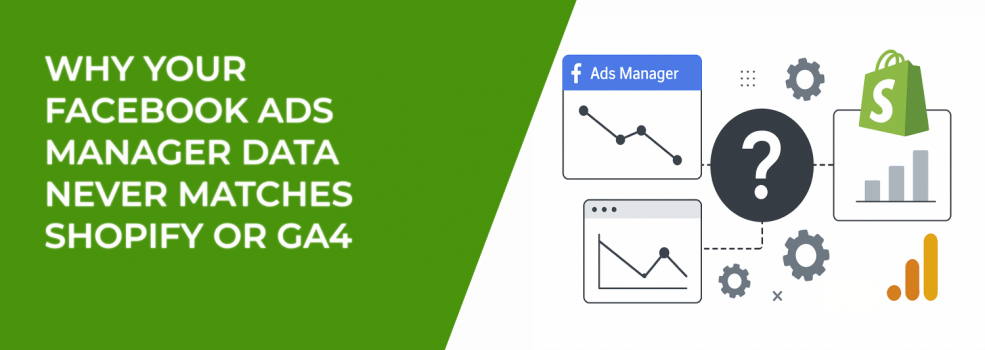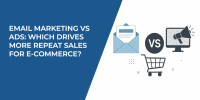Every advertiser knows the frustration. You check Facebook Ads Manager, then compare it to Shopify or GA4, and the numbers don’t line up. Sometimes they’re close, but often the gap feels huge. Which numbers should you trust?
The answer isn’t simple, because each platform measures data differently. Facebook focuses on people and their journeys, Shopify records completed transactions, and GA4 looks at sessions and traffic patterns. These perspectives are not wrong, just different. The challenge for marketers is to understand why the numbers don’t match, and how to interpret them without getting misled.
Why Discrepancies Are Normal
Facebook, Shopify, and GA4 use different rules to define conversions and assign credit to ads. That’s why their reports rarely look identical. This is expected, but the size of the discrepancy matters. A small 10–20% difference is often acceptable. A 50% gap usually points to deeper issues.
A simple example: if someone clicks a Facebook ad and buys right away, all three platforms will usually agree. But if that person waits a few days, comes back through a Google search, or clicks an email before finally purchasing, every platform assigns credit differently. That’s why the numbers diverge — each system is telling the story through its own lens.
Why Facebook and Shopify Disagree
1. People-based vs. Session-based Tracking
Facebook tracks users across devices if they’re logged in. Shopify focuses only on what happens in its own store. If a shopper clicks an ad on their phone but later purchases on their laptop, Facebook will connect the dots — but Shopify may miss it entirely.
This explains why Facebook often reports more conversions than Shopify.
2. Different Attribution Windows
Facebook uses attribution windows like 7-day click or 1-day view. Conversions can be credited to ads that influenced a purchase days earlier. Shopify doesn’t use lookback windows; it simply records the sale when it happens.
For instance, if someone clicked an ad, thought about it for a week, and then bought, Facebook would still count the sale, while Shopify would just log the transaction without attribution.
3. View-through Conversions
Facebook also gives credit when people saw an ad but didn’t click, provided they purchase within the view window. Shopify has no way of recording this. That’s why Facebook’s totals are nearly always higher.
4. Duplicate or Multi-touch Counting
Facebook often spreads credit across multiple ads a person interacts with, while Shopify records only one sale. This can make Facebook appear to “double-count,” but really it’s just dividing credit across touchpoints.
5. Tracking Failures and Ad Blockers
Sometimes the Pixel doesn’t fire due to a slow page load or an ad blocker. In that case, Shopify records the purchase but Facebook doesn’t. Conversely, Facebook’s Conversions API might log data that Shopify doesn’t classify the same way.
This is why understanding proper setup is so important. If your Facebook ads are not converting, it’s not always because of bad targeting or weak creative — sometimes the real issue is a tracking mismatch.
Why Facebook and GA4 Disagree
1. Clicks vs. Sessions
Facebook counts every ad click. GA4 only records a session if the page loads and the tag fires. If someone clicks but leaves before the page loads, Facebook will log it, but GA4 won’t.
2. Different Attribution Models
Facebook uses its attribution windows, while GA4 defaults to last non-direct click. If a customer first clicks a Facebook ad but later buys after Googling your brand, GA4 will give the credit to Google, while Facebook still attributes the sale to the ad.
3. Multiple Clicks in a Short Time
If one shopper clicks your ad twice within 30 minutes, Facebook counts two clicks, while GA4 treats it as one session.
4. View-through Conversions
Facebook includes conversions influenced by ad views. GA4 ignores these entirely. That’s why GA4 almost always shows fewer conversions than Ads Manager.
5. Privacy Restrictions and iOS Updates
Privacy rules cause GA4 to lose visibility in some cases. Facebook tries to bridge the gap with modeled conversions. As a result, GA4 often underreports compared to Ads Manager.
6. UTM Tagging Problems
If campaigns aren’t tagged properly, GA4 may group traffic into “direct” or “other.” This makes Facebook look more generous with conversions and GA4 more conservative.
These points highlight why Facebook and GA4 often feel “out of sync.” This is why setting the right campaign objectives in Meta Ads is so important — it defines how attribution is measured and ensures you’re comparing the right numbers.
How to Work With These Differences
Marketers don’t need exact alignment — they need consistency and context. Here’s how to approach it:
-
Set a tolerance level. Accept a small gap of 10–20% as normal. Larger differences should trigger investigation.
-
Choose a main reporting tool. Whether it’s Facebook, Shopify, or GA4, pick one system as the “source of truth” and use the others for comparison.
-
Focus on patterns, not absolutes. If all platforms show an upward trend in conversions, the exact totals don’t matter as much as the direction of growth.
-
Verify with back-end data. Actual orders in Shopify or your CRM are the ultimate ground truth. Compare ad spend against real revenue to validate performance.
For example, if Shopify reports most sales as “direct” or “organic,” but Facebook shows steady conversion growth, the reality is likely that Facebook influenced those sales early in the funnel. This is where knowing how to define your target audience step by step can help you align campaign data with real customer behavior.
Steps to Reduce the Gap
There’s no way to completely eliminate differences, but smart adjustments can bring numbers closer:
-
Use both Pixel and Conversions API. The Pixel captures browser activity, while CAPI sends data from your server. Together, they provide stronger tracking and reduce data loss.
-
Align attribution settings. If Facebook uses a 7-day window but GA4 is last-click, the results will look completely different. Adjust settings where possible to make them more comparable.
-
Tag every ad with UTMs. Proper UTMs (e.g., utm_source=facebook
) make sure GA4 classifies the traffic correctly. Without them, much of your ad traffic may end up in “direct.” -
Audit tracking setup. Regularly test whether your Pixel and GA4 tags are firing properly. Check for duplicates, missing events, or broken scripts.
-
Boost Event Match Quality. Send hashed customer data like email or phone number with events so Facebook can match them to users more accurately.
-
Exclude view-through conversions if needed. Turning them off in Facebook reports can make numbers closer to GA4’s click-based logic.
-
Sync time zones. If platforms use different time zones, daily numbers will never match. Standardize them across all tools.
-
Segment by device. Compare mobile and desktop separately. Mobile tends to show larger gaps due to privacy restrictions and tracking limitations.
When tackling these adjustments, it’s useful to revisit the basics of Facebook ad targeting. If your targeting isn’t aligned, no amount of tracking optimization will give you reliable results.
Final Thoughts
Facebook Ads Manager, Shopify, and GA4 will never completely agree — and that’s okay. Each platform serves a different purpose, uses its own rules, and provides unique insights.
The key is to accept small gaps, investigate large ones, and build a system where data is consistent enough to make good decisions. Look for trends over time, cross-check with real sales, and keep improving your tracking setup.
In the end, what matters most isn’t having identical numbers, but knowing how to interpret the differences. That understanding is what allows marketers to confidently scale campaigns and drive growth.

